Paul Daniel, paulantdaniel@arrakis.es
Dr Nicola Careddu, ncareddu@unica.it
Building stone has been extracted from underground in certain parts of Europe for centuries. In the 20th century, stricter legislation has sometimes restricted opencast quarrying with the result that under favourable geological conditions, underground mining is adopted. The economic aspects are paramount. In this report, Paul Daniel identifies some active stone mines, while Dr Nicola Careddu describes a particular project in Italy.
Why should the owners of a dimension stone quarry consider “going underground”?. Parker (1996) identified three advantages: 1) surface developments, zoning issues, and environmental concerns are often less of an issue; 2) stripping and restoration requirements are eliminated, and 3) additional reserves are often available beneath the quarry floor, under pit slopes, or under adjoining property. There are also added benefits including working in a constant climate - no rainfall, frost or high winds. There are of course also disadvantages including higher initial opening cost and safety issues. On balance, however, Parker believes that "Everybody goes underground eventually”. He is referring in particular to stone that is crushed into aggregates - there are reportedly more than 120 underground quarries in the USA whose end product is crushed stone. Dimension stone extraction underground may also gain in popularity due to environmental and land use issues. For this article, we have asked mining engineers employed by operators of underground dimension stone mines in several countries for their views.
It seems that some ancient Romans first went underground for stone, so we will start - and end - our survey in Italy.
ITALY
Underground mining of dimension stone is carried out at several sites in Italy. It is currently performed using technologies that do not cause damage to the material, i.e. without the use of explosives. There are more stability problems than with opencast quarrying, because of the empty spaces (rooms or chambers) created, but there are no substantial differences in the cutting technology. A suitable combination of chain saw and diamond wire has been used successfully since the late 1970s.
Around 10% of marble deposits in the Apian Alps region are mined underground today. To extract siliceous rocks such as granite underground is however fraught with difficulties of a practical and economic nature. Only waterjet technology, combined with diamond wire, complies with all the necessary requirements but it is currently too expensive for practical implementation.
The choice of extraction equipment and method depends on several factors, including the block size required, the transportation means available on the market and, finally, the parameters of structural stability (Careddu et al, 2010a) and rock support. Considerations of the optimum yield of gangsaw blocks, workplace safety, and subsequent use of the underground chambers are also important.
Geomechanics studies must include in situ investigations, laboratory tests, analytical and numerical modelling and monitoring (Ferrero, 2001).
There are three basic methods employed for the underground mining of dimension stone:
- (a) tunneling (also known as ´long face quarrying´);
- (b) large pillar mining;
- (c) rooms and pillars mining.
A famous example of method (a) is to be found at a mine in Candoglia, near Lake Maggiore, where stone for the restoration of Milan Cathedral (Il Duomo) has been extracted since the early 15th century. Another example can be found at a mine in Puglia, south Italy.
The serpentinitic marble Verde Patrizia is currently mined in Val d´Aosta using the large pillar method (b).
The rooms and pillars method (c) is mainly used in massive limestone or marble deposits. In Italy there are a lot of stone mines where method (c) is adopted, especially in the Apuan Alps district where the famous Carrara marble is extracted. Other areas include Liguria where slate is mined and Val Brembana, Lombardy in north Italy where Arabescato Orobico marble is extracted.
A description of a new project to mine hard limestone in Sardinia will be given later on.
UNITED KINGDOM
The Romans came to colonise the British Isles in 43 AD. At Beer in East Devon, an excellent building stone was discovered. We know that underground working was undertaken because Roman coins and pottery were found at the site. Some 1800 years later, limestone was mined underground extensively at several sites in England including Dudley in the Midlands and Godstone in southern England. In Wales, a lot of slate was extracted underground. Today only limestone is mined underground, principally in the Bath and Portland areas.
Beer
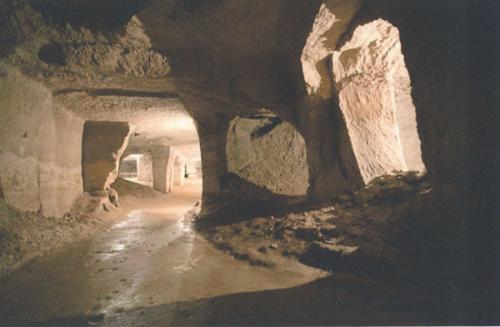
This part of Beer mine in England was worked in 16th Century (Courtesy of John Scott FRSA, BEER QUARRY CAVES LTD.
The mine complex at Beer ceased to become active a long while ago. However we mention it here because of its great historical significance. A seam of creamy-white crystalline, granular limestone was deposited during the Upper Cretaceous period. The seam is only 4 m thick and it rests on Cenomanian limestone. Beer stone has been found at Roman villas near the source. Around 1000 years later, Beer stone was used in 24 British cathedrals including Exeter, Winchester, St Paul’s in London, parts of Westminster Abbey, the Tower of London and at Hampton Court. The mine complex comprises 73,5 acres (29,7 Ha) of underground space, cut out entirely by hand over a period of almost 2000 years. Figure 1 shows a part of the Beer complex created during the Tudor period (1485 - 1603 AD).
Bath
Bath Stone is a golden coloured Oolitic limestone deposited during the Middle Jurassic period. The Romans were prolific users of Bath stone - evidence of its use has been found in several villas plus the main Roman baths in the City of Bath itself. Many of the underground mines are now abandoned but some are still operating. There are currently two mining companies - Hanson Bath & Portland, and Bath Stone Group. The former company operates three Bath stone mines - two in Wiltshire and one near Bath. Hanson have dug down into the floor of their mine at Hartham Park to extract Box Ground Bath Stone for the first time in 50 years. Mr. Shahram Hakimzadeh runs the Hanson Bath & Portland mining operation. Elaine Marson, owner of the Bath Stone Group, says “The reason we mine and not quarry is because the planning conditions are strict when the mineral area is within a designated area of outstanding natural beauty”.
Portland
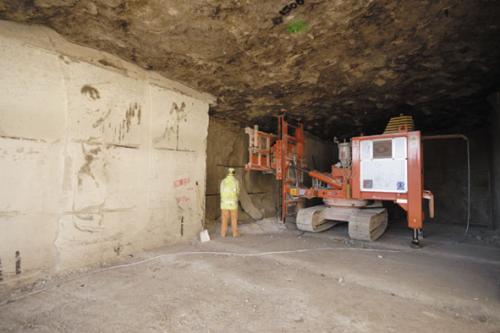
Bowes mine, Portland (Courtesy of ALBIO STONE PLC.)
Portland stone was used for the construction of St Paul´s Cathedral and Buckingham Palace. Though the stone is still in high demand, further extraction from the surface on an island measuring just 7 by 3 km was not acceptable so a plan to extract from underground was drawn up. The resultant Bowers Trial Mine was opened in October 2002 using advanced drilling techniques, diamond wire and special ´Jet-belt´ diamond belt equipment imported from Italy. A bed of high quality limestone averaging 6 m in thickness is being extracted (Figure 2). Further underground mines are planned. Michael Poultney, managing director of Albion Stone Quarries, commented on obtaining the planning approval "This is wonderful news for the industry and the environment”. A current advertisement by Albion shows “A game of cricket above, mining below “.
CROATIA
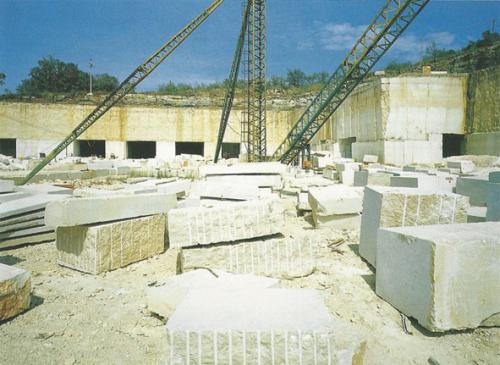
Opening of Kanfanar III mine, Croatia. (Courtesy of KAMEN PAZIN)
The Romans (and the Greeks before them) discovered excellent building stone along the coasts of Istria and Dalmatia. Modern extraction technology has helped Croatia to become a significant exporter of quality limestone. In the monograph KAMEN PAZIN 1954-2004, mining engineer Ivan Cotman wrote “Growing concern for ecological protection ... makes expansion of the quarry areas increasingly problematical. Underground mining has two major advantages: the possibility of working in all weather conditions, and minimal environmental impact”. In 1994, Mr. Cotman designed and introduced underground working at the company´s Kanfanar site using the theory of finite elements. The state of stress underground is monitored using pressure cells. The projected values are always confirmed in practice. In 2002 Kamen Pazin took delivery of its first type GU 70 computerised, self-propelled cutting system supplied by Fantini of Italy. This system can generate openings up to 5,3 m in height and of any width. The size of the chambers created underground facilitates work using heavy loading and transporting machinery. Another of Kamen Pazin´s quarries, Vinkuran is located within today´s boundaries of the city of Pula so that stone extraction can only continue underground. It was stone from this source that was used to build Pula Arena around 2000 years ago.
Writing in November 2010, Mr. Cotman noted that Kamen Pazin´s production is now over 12,000 m3 a year. Figure 3 shows some of the entrances at Kanfanar II mine.
SLOVENIA
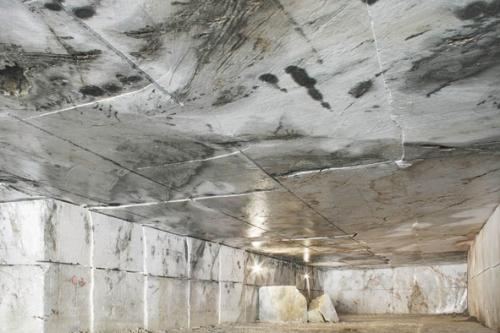
Marmor Hotavlje, Slovenia. (Courtesy of MARMOR HOTAVLJE)
Underground mining of coloured marble commenced in 1993 at a site (Figure 4) owned by Marmor Hotavlje about 50 km northwest of Ljubljana. The current annual volume of production is around 500 m3. To the west and near the Italian border is Marmor Sezana, who received technical advice from Hotavlje in developing underground working below Lipica II quarry. Again an attractive coloured marble is extracted which remains popular in Slovenia and adjacent countries.
BELGIUM
Noir Belge (Belgian Black) marble is mined at Golzinne, south-west of Brussels. The mining company is part of the Solubema group, the largest marble quarrying concern in Portugal. Found in Roman villas built some 2000 years ago, the black colour of this ´marble´ is due to a high content of unaltered organic matter. It is a fine grained calcareous sedimentary rock of Upper Devonian age, found on the northern edge of the Namur sedimentary basin. At one time quarrying of decorative stone took place at many sites in south-western Belgium but the number now is very limited. Today at Golzinne about 200-250 m3 of Noir Belge is extracted per annum. Geologist Francis Kezirian says that the galleries are 10 m wide by 3,30 m high. Underground mining here began in 1928 because the marble benches dip 17 degrees and there was too much overburden to remove for viable opencast quarrying. Mining is currently carried out about 70 m below ground at the deepest part.
PORTUGAL
Some time ago, the first author visited a micro-mine - a vertical shaft perhaps 4 m wide from which a hard, dense black slate was being extracted. Adjacent to the mine shaft at Valongo, not too far from Oporto, was a new custom-built factory processing the slate blocks into billiards and snooker table slabs. Today there are two leading companies in the area. Pereira Gomes & Carvalho Lda operates 3 underground mines. Although the company still has significant reserves in its present mines, prospecting over an area of around 50.000 m2 has revealed reserves sufficient to open 10 new mines. The present production capacity is about 7000 tons a year. Around 80% of finished slabs, tiles and other products are exported to several European countries, Japan and the USA. The slate is of Upper Landellian age.
SPAIN
There are more than 800 active dimension stone quarries in Spain but apparently only one mine extracting from underground - it is owned by Explotaciones Calcita SL. The mines are located in Catalonia, not far from Barcelona. The annual volume of production is around 5.000 m3 of blocks. The reserves are calculated to last for about 10 more years. High quality calcite is mainly used for sculpturing and there are excellent examples of its use at the famous Sagrada Familia Temple in Barcelona.
GREECE
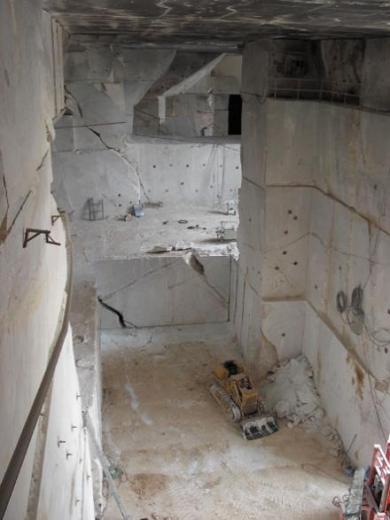
Some marble from DIONYSSOS GROUP in Greece comes from underground.
Dimension stone, and especially marble, has been extracted in Greece for at least 2500 years. Construction of the Parthenon to replace an earlier Temple began in 447 BC. Pentelic marble was selected as the main building material. After various natural and military disasters over the ages, a Committee for the Restoration of the Acropolis Monuments was established in 1983. New Pentelic marble is being used from the original quarry. Restoration work continues to this day. Since 1949 the quarry belongs to the private company SA Marble Quarry Dionyssos Penteli. Today the company operates 9 opencast quarries and 2 underground mines. As Mr. Leftis Kazatsanidis, director of the Dionyssos quarry, explained “One underground mine (Figure 5) is situated at Dionyssos-Athens and the second is at Volakas-Drama. Underground operation at Dionyssos started in 1994, and at Volakas in 2007”.
According to Mr. Kazatsanidis, “The main reason for going underground was the problem of disposal of the overburden. It is very difficult to get a permit to deposit the waste. The disadvantages of underground exploitation are the much higher cost (compared with opencast quarrying) and the fact that a large amount of marble remains in situ unexploited, as pillars. The big advantage is that it has minimal environmental impact, as well as minimal emissions of dust and noise.
The current annual volume of production is about 1.000 m3 at each underground site. The majority of our company´s marble blocks are obtained from opencast quarries”.
USA
Polycor, Inc is the second largest dimension stone producer and processor in North America. The group headquarters are in Quebec, Canada.
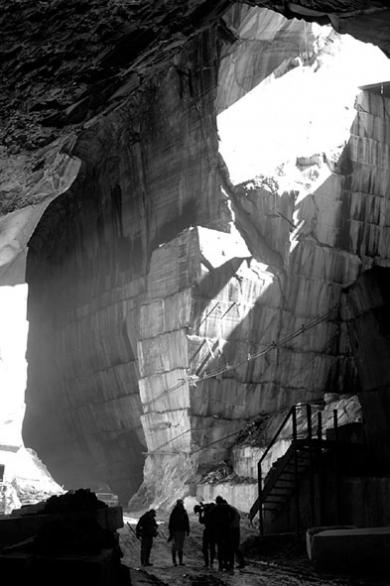
Mining at 3,100 m. Colorado Yule mine (USA). Courtesy of Ron Bailey, POLYCOR INC.
Polycor operates over 25 of its own quarries throughout North America including the Colorado Yule white marble mine which was acquired in 2004. The deposit is found in the West Elk Mountains of Colorado near the town of Marble and is said to be one of the largest of its type in the world. At 99,5% pure calcite, this is one of the purest marbles ever quarried. The source was discovered in the late 1870s at an elevation of 9.500 ft (3100 m). Closed in 1941, some quarries were reopened in 1990 before acquisition by Polycor, Inc. A video on the Polycor website shows some of the underground workings. Figure 6 shows part of the site.
RUSSIA
Underground mining of limestone was undertaken in Leningrad Region in the early 1990s but only as an adjunct to the mining of oil shale. It is no longer practised. The subterranean mining of marble at Kibik-Kordon, Sayan district, Khakassia however was begun in 2006 and is continuing. Deposits of marble along both banks of the local river are massive. There are several colour varieties including white, pale pink and cream, to grey, pinkish-orange and bright pink. Because of sharp dipping of the marble beds (20 - 30 degrees in places), it was decided to try underground mining in combination with opencast quarrying where high quality marble was known to be present. The local mine engineers were aware of Italian technology. At Kibik-Kordon the entrance tunnel (drift) is now 41 m long. Chambers have been created and large blocks of pink marble extracted. The Kibik-Kordon deposits are owned by MKK Holdings of Moscow. A very recent innovation is the mining of limestone in a former coalmine in Tuia region. The initiative is financed by the International Bank for Reconstruction and Development.
BRAZIL
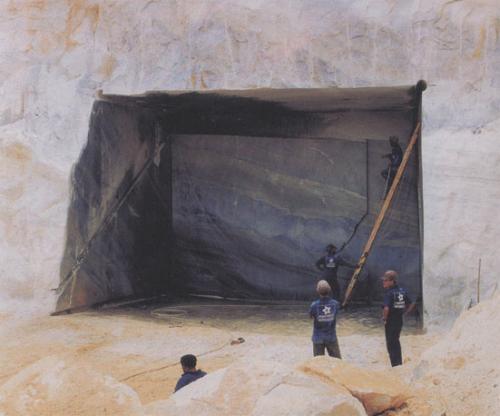
Entrance to quartzite mine in Brazil. (Courtesy of Yuri Sychov)
Around 2500 km) from Sao Paulo there is an underground mine extracting Blue Imperial Quartzite. In the past there were some problems with structural stability in parts of the entrance tunnel, and two rockfall incidents. The problems were resolved and the mine has been operating again for a while. The source of the valuable blue quartzite is located near the small city of Oliveira dos Brejinhos in the State of Bahia, in north-east Brazil. This is the only active underground dimension stone mine in the country. Figure 7 shows the entrance.
MOLDOVA
White limestone has been extracted underground at various sites in Moldova for centuries. In 1953 while exploring an abandoned mine beneath the capital city Chisinau, some wine production experts confirmed this would be an ideal place for quality wine storage. Ironically, the wine companies came to realise the excellent qualities of the limestone as a building material. The basic product is a building block called a kostelets typically measuring 390 x 190 x 188 mm. The two biggest wine companies inherited tunnels totalling around 200 km and 100 km in length respectively and both created stone production subsidiaries.
Mina din Chisinau was established in 1969 based on the fact that geological surveys had confirmed reserves of 43,8 million m3 of mainly oolitic white limestone below the northern suburbs of Chisinau. The formations of interest lie horizontally in strata 8 - 10 m thick from 60 - 80 m below the surface. The target formations were accessed by driving two sloping drifts round 600 m in length. Chambers or rooms were created 7,5 m in width and 2,6 m high. The pillars measure 20 x 20 m. Mina din Chisinau has twelve custom-designed cutting machines with circular blades. Though the website text is in Russian, pictures of sawing machines can be seen on www.mina.md
UKRAINE
The shelley limestone below the city of Odessa and its surroundings in the southern Ukraine is riddled with up to 2500 km of catacombs. They weren´t used as cemeteries but were formed by Cossacks and other residents who mined the land for the stone. Building intensified around 1830 and the mines provided the main construction material for many homes and buildings. Stone mining here was banned after the Russian revolution in 1917. Today there are perhaps five small companies extracting limited amounts of the very porous limestone which has a low compressive strength. (There is better quality material beneath Odessa city centre but mining there is forbidden). The extraction process using a small chainsaw mounted on a portable framework is shown in http://youtube.com/watch?v=j3cKFq3cNWk
The building blocks are usually covered with plaster after installation. The traditional stone companies in the Ukraine look down on shelly limestone, yet it is a natural material requiring very low energy cost for extraction - a ´green ´ alternative to cement, bricks and mortar.
In Sardinia, transformation from opencast to underground exploitation
The first underground exploitation of a limestone deposit in Sardinia, Italy is about to commence. There are several factors that led to the decision to go underground. Firstly, local public opinion and the development of an environmental protection policy had led to stricter constraints on opencast quarrying. It is also relevant that after a certain strip ratio, opencast quarrying becomes uneconomic. Moreover, in the Orosei Marble District you can reach better quality stone. Finally, by going underground there is less production of waste.
The Orosei project involves the transformation of an opencast quarry area (named “Su Cuccumiau” and shown in figure below to underground working. The transformation will be made gradually, as it is necessary to reconfigure the existing terraces to ensure the structural safety of the underground operations. It is also important to obtain a design of the quarry faces that is in harmony with the landscape and permitting an easy revegetation of the quarry areas. Over the next 10 years, the production of blocks underground will begin, develop and, simultaneously, opencast quarrying will continue.

Opencast quarries "Su Cuccumiau"
Quarrying activity and marble processing in Orosei district (NE Sardinia) on the slopes of Mt Tuttavista thrived in the 1960s, to become a significant industrial activity. Currently the annual production of Orosei marble blocks is approximately 300.000 m3 and the industry provides employment for more than 400 skilled workers. There are 15 individual quarries mostly with their own processing plants. Continued growth is likely on account of the dynamism of the local businesses promoting Orosei Marble in world markets.
After some 40 years only about 12% of the proven reserves at Orosei have been extracted and only some 70 hectares of land affected by the quarrying activities.
The mountain is mainly composed of Mesozoic limestone and dolomitic parts of layers from the Jurassic and Cretaceous ages. The Mesozoic geology gives rise to a dense limestone of varying beige colour including light, veined and cloud-like. Although commercially described as ´marble´, the Orosei stones are technically limestone and dolomite calcareous rocks of non-metamorphic origin.
A key step
A key step in designing an underground dimension stone mine in the Orosei area was of course to obtain an accurate geo-mechanical characterisation of the rock mass. From these results it was decided to adopt the ´rooms and pillars´ method. It is important to emphasize that mining will be undertaken at shallow depths, so the openings will show a behaviour affected mainly by discontinuities in the rock mass. Studying the shear strength of joints therefore became critical.
Geo-mechanical surveys, carried out initially by photo-interpretation at different scales, located a series of fractures at Monte Tuttavista running directly NS, EW, NW-SE and NE-SW, with a spacing varying between 10 and 40 m.
To integrate and verify the information from previous surveys, further studies based on geophysical methods were carried out due to their fast application and easy interpretation of results. More exactly :
- electromagnetic prospecting based on Very Low Frequency (VLF) to small scale and wide area ;
- a seismic survey, in conjunction with VLF electromagnetic prospecting on a small area, carried out in great detail in the “Su Cuccumiau” open cast quarry.
The VLF method is not often used in mining prospecting, but combining its data with those from measurements in situ and seismic profiles, you can obtain a lot of information and a more accurate geo-structural interpretation. Methods allowed also to recognize better the discontinuities.
To allow correct geostructural planning and design for the´rooms and pillars´ method, it was also necessary to analyze the characteristics of the intact rock.
A test sequence was devised in the laboratory on a large number of specimens to find the minimum resistance to various stresses. These values, together with the model of the rock mass discontinuity, were introduced as reference data for the structural calculations and verification of the safety factor, using specific software.
During the in-situ surveys, all the characteristics of discontinuities in the rock mass of “Su Cuccumiau” were detected. Measurement of the parameters needed to determine the shear strength of the different families of discontinuity was also carried out according to the Barton & Choubey criterion. This empirical criterion takes into account the roughness of the joints and resistance of the wall.
Current work
Currently the engineers are working on the final arrangement of the quarrying faces, both for setting of the quarry floor in front of future tunnel access and for the open faces remodelling, in order to limit the impact on the landscape. A careful analysis of slope stability at the access point of the tunnel was made in order to relate the intersection of the quarry face with the joints, thus identifying all the blocks that can occur and attributing to them an appropriate safety factor. Stress development during the underground exploitation was also studied in rock mass modelling, using suitable software based either on the Finite Element Method or the Boundary Element Method. The correct design of the support was translated into a Safety Factor on which the best solution in terms of cost and safety will be chosen.
Geo-structural calculations have ruled out the possibility of any problems of subsidence within the concession area.
The geometries of both rooms and pillars have been chosen by an interactive process, which has, as initial data, the size of a gangsaw block, , the optimum yield in gangsaw block production, the geometric characteristics of the cutting equipment and transportation currently available on the market, the parameters of structural stability, the workplace safety and, finally, the next use of the underground spaces for other purposes.
Exploitation is divided into three levels as listed in this table:
| Levels | Floor altitude (m.a.s.l.) | Roof altitude (m.a.s.l.) | Height (m) | Area (m) | Volume (m3) |
| 1 | 203 | 235 | 32 | 27,433 | 161,810 |
| 2 | 149 | 180 | 32 | 135,564 | 1,248,393 |
| 3 | 102 | 134 | 32 | 172,723 | 1,542,558 |
| total volume | 2,952,751 |
An overburden of more than 20 m has been left over the first level due to the strong alteration of the rock mass.
The roof dividing the 1st level from the 2nd one has a thickness of 20 m and is located at the same altitude as the main quarry floor. This thickness ensures a high level of stability, and prevents any subsidence on the surface.
The roof that divides the 2nd level from 3rd one is of 15 m thickness, which ensures adequate stability and greater recovery of material from the rock mass.
The first access tunnel will start from +230 m a.s.l. (meters above sea level). It will be used either as the main access way to the first exploitation level or as the main service one. Moreover, both the geo-mechanical characteristics of the rock mass and the quality of the limestone will be further checked here.
The first stage of excavation will be a dead-end to reach the second exit connected with the main quarry floor (+230 m a.s.l.). This is necessary both for safety and for the ventilation of the underground work.
According to the geo-structural calculations, it will be necessary to leave in place a continuous pillar (in N-S direction) along the exposed side of the main quarry floor. This will have a minimum thickness of 15 m, to ensure the stability of the first level. However, this will happen only in the first level - in others the border will be decided by the limits of the mining concession and the limitations imposed by the thickness of the roofs to be left in place. A 3-D model of underground exploitation is shown in this figure:

3D model of underground exploitation of Orosei.
Each level is divided into four panels ; the first will be 4.5 m in height, the same height as the access tunnel. Exploitation will be carried out directly, by cutting out blocks with a diamond chainsaw and diamond wire, and transported to the outside by a low loader.
The second, third and fourth panels will be accessed by an opening channel created by cutting horizontal slices using the same diamond technologies. This channel will create the space required for the separation of benches. The previous panels will be 9 m in height, corresponding to that of benches. Excavation will then proceed in all directions in order to obtain a large room that will house the machines for bench cutting, slab tipping over and transportation of mined blocks.
The geometry of rooms and pillars, listed in table below, allows counterbalancing an increasing trend of stresses from top to bottom, mainly due to the increased load of rock above it.
| Levels | Pillars distance (m) | Pillars squared section (m) | Rooms squared section (m2) |
| 1 | 30 | 25 | 900 |
| 2 | 30 | 36 | 900 |
| 3 | 29 | 49 | 841 |
Exploitation will obviously start from the first panel, by the opening of the access tunnel and the cut of the first benches inside the rooms.
In the empty space left as the tunnel and quarrying progress, reinforcement of the roof will be undertaken using of rock bolting (eventually integrated with the installation of a welded mesh, in the case of highly fractured zones), which will also be used along the walls fractured during the deepening of the rooms in order to make excavation safer.
The different stages of surface quarrying and underground exploitation were designed in harmony with the development and environmental recovery plan. During the opencast operations, gradual remodelling of the quarry faces will proceed, ensuring also a continuous connection between the terraces. When the final landform is achieved, the surface will be stabilized by vegetation (Hustrulid, 2006); modern bioengineering techniques will be used.
A detailed feasibility study for the underground mine "Su Cuccumiau" was drawn up ; it was also completed by economic and financial analysis (Careddu et al., 2010).
In particular, economic analysis shows that sales of Orosei Marble, from the second year of the exercise, will amount to over 5.7 million €, while the added value in the same year will be approximately 3.8 million € with an operating gross margin of about 3.14 million €.
Literature references
Parker, J. Everybody goes underground eventually. Aggregate Manager, June 1996, 6, pp 30 - 35.
Barton, N.R. and Choubey, V. (1977). The shear strength of rock joints in theory and practice. Rock Mech. 10(1-2), 1-54.
Careddu, N., Siotto, G., 2010. Geo-mechanical characterization for the underground marble mine “Su Cuccumiau” (Sardinia). Proc. 7th International Marble and Natural Stones Congress of Turkey (Mersem VII), 14-15 October 2010, Afyonkarahisar, Turkey. Pagg. 25-32. Ed. M. Ersoy, M.Y. «elik, L. Yeşilkaya. ISBN: 978-605-01-0023-5.
Careddu, N., Siotto, G., Tuveri, A., 2010. Evolution of a marble quarry: from open cast to underground exploitation. Proc. Global Stone Congress 2010, 2-5 March 2010, Alicante, Spain. S1-01. Ed. AIDICO (Instituto de la ConstrucciÛn), ValËncia. ISBN: 978-84-614-1147-4.
Ferrero, A. M., 2002. Rock mechanics studies applied to ornamental stone design. Part of the project “Development of an integrated computed aided design and planning methodology for underground marble quarries”, Contract No. BE-5005, 2002.
Hustrulid, W., Kuchta, M., 2006, Open pit mine planning & design, 2_ ed., Taylor & Francis plc., ISBN 90-5410-184-9, pag. 30.
Primavori, P., 2004. Planet Stone. Giorgio Zusi Ed., Verona, Italy. ISBN 88-900067-9-X.
